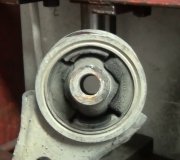The car should be aligned regardless of any pull or off-center steering wheel. The upper ball joints will definitely not be in the exact same position as before. If both wheels are now tipped in or out on top the same amount, those two pulls will offset each other so the car can go straight, and the steering wheel can be straight, but due to the suspension geometry, tipping a wheel also causes it to turn left or right. Again, if both sides are incorrect but equal, you won't notice a pull, (usually), but the tires will be steering away from or toward the center of the car. That will cause rapid tire wear with a feather-edge pattern on both tires. If the tires are steering away from the car's center, it will severely over-react to side winds and when roads slant to the right. You'll be constantly correcting the steering wheel.
Here's a trick that I don't share with everyone. Jack up one corner of the car and support it solidly on jack stands. Remove one front wheel, then reinstall two lug nuts to hold the rotor tight. Use a magnetic angle gauge stuck on the rotor and read the angle or set it to "0.0" Replace the strut assembly on that side, then check the angle with the gauge. If necessary, slot the lower mounting hole to get the same angle that you started with. That should put camber for that wheel right back where it was. On some cars the upper mounting plate holes are slotted or at least have a little room to slide the mount in or out to achieve the same thing.
Put the wheel on, be sure to torque the lug nuts with a click-type torque wrench, then go out and drive the car. If the steering wheel was straight before, and it's straight now, the suspension geometry is the same as before, including camber. This won't get you to the hundredth of a degree accuracy for camber like all alignment computers can measure to now, but it will get you within a tenth of a degree, which used to be the standard.
Now do the same procedure with the other side. Don't try to do both struts at the same time. If the steering wheel is no longer centered, there's no way to know which strut was not adjusted properly, or if both are wrong.
Wednesday, October 7th, 2015 AT 6:32 PM


